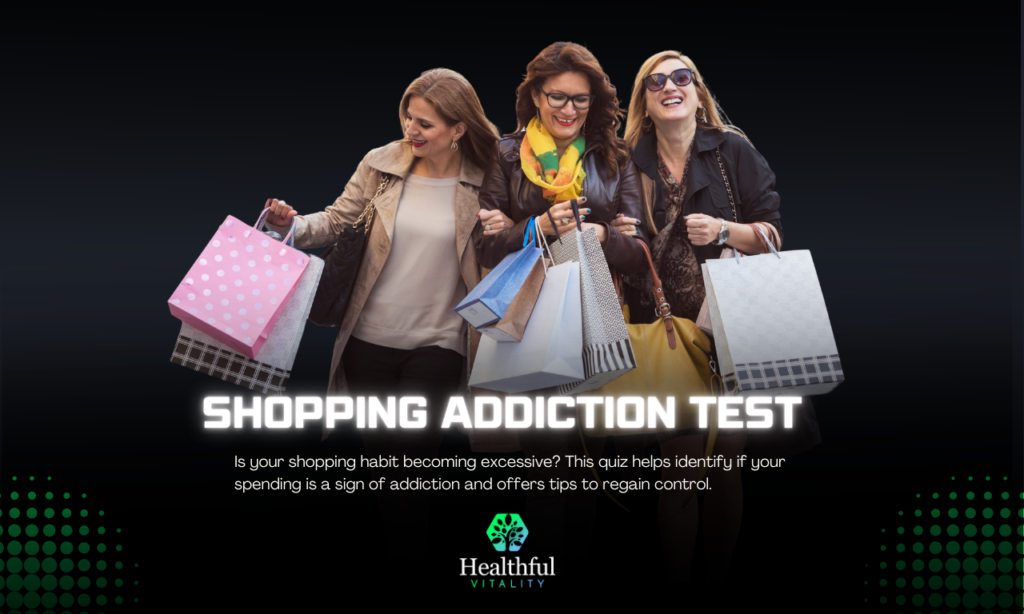Shopping Addiction Test

Understanding Shopping Addiction
Shopping addiction is a complex behavioral issue marked by compulsive buying that disrupts finances, emotions, and everyday routines. This test is designed to help you reflect on your spending habits and recognize patterns that may indicate more profound issues.
What Is Shopping Addiction?
Shopping addiction, or compulsive buying behavior, goes beyond occasional impulse purchases. It involves a persistent urge to shop, often leading to overspending and emotional distress. This condition can strain relationships and cause significant financial difficulties.
A Closer Look at Compulsive Buying Behavior
Compulsive buying behavior is characterized by repeated, uncontrollable urges to purchase items, regardless of need. The behavior is driven by emotional triggers, creating a temporary sense of relief that soon gives way to guilt and anxiety.
How Shopping Addiction Impacts Finances, Emotions, and Daily Life
The consequences of shopping addiction are far-reaching. Financial instability, mounting debts, and damaged credit often accompany the emotional turmoil of regret and low self-esteem. Daily routines may suffer as the preoccupation with shopping crowds out responsibilities and personal growth.
Why Take the Shopping Addiction Test?
This test offers a structured way to examine your spending habits. By identifying signs of uncontrolled spending, you can gain clarity about whether your purchasing behaviors are a coping mechanism or a sign of deeper issues.
Identifying the Signs of Uncontrolled Spending Habits
Recognizing the warning signs—such as impulse buying, regret after purchases, and using shopping to cope with negative emotions—is the first step. Understanding these signs can prompt proactive changes before financial or emotional harm escalates.
How This Test Can Help You Recognize and Manage Shopping Addiction
By reflecting on specific behaviors, the test guides you to a clearer understanding of your relationship with money. It is a self-reflection tool, not a diagnosis, but it draws on insights from behavioral and addiction psychology to help you see where you stand.
Who Is This Shopping Addiction Test For?
Our Shopping Addiction Test is designed for individuals who struggle with impulsive shopping and find themselves purchasing items even when they aren’t needed. It is equally useful for friends, family, and loved ones trying to recognize the signs of shopping addiction in someone they care about.
Is This Shopping Addiction Test Accurate?
While no self-assessment can capture every nuance, this tool is grounded in professional insights and research. It serves as a starting point for understanding your spending habits rather than a definitive diagnosis.
Purpose and Development of the Test
Developed using insights from behavioral and addiction psychology, this test is intended as a self-reflection tool. It encourages you to consider your emotional well-being alongside your financial behaviors and is a prompt to seek professional guidance when needed.
When to Seek Professional Guidance
If you notice persistent patterns of compulsive buying, therapy or financial counseling may help. Professional support can guide you through strategies such as budgeting techniques, recognizing triggers, and joining support groups.
Recommendations Based on Your Results
- Low Risk of Shopping Addiction: Continue maintaining healthy spending habits and be mindful of emotional triggers.
- Moderate Risk of Shopping Addiction: Recognize triggers that lead to overspending and adopt strategies to set spending limits.
- High Risk of Shopping Addiction: Understand the serious emotional and financial consequences; consider exploring therapy, budgeting techniques, and support groups for long-term recovery.
Let’s Recap
You’ve learned how shopping addiction can impact your emotions and finances. Recognize whether your spending habits are within control and consider the next steps for financial and emotional balance. Taking small, deliberate steps toward healthier shopping behaviors is key.
Frequently Asked Questions
What Causes Shopping Addiction?
Emotional distress, low self-esteem, and the allure of retail therapy can drive compulsive buying.
How Is Shopping Addiction Different from Regular Shopping?
It’s defined by its frequency and the negative impact on your life.
What Are the Warning Signs of Shopping Addiction?
Frequent impulse purchases, regret, and using shopping as an emotional crutch.
Can Shopping Addiction Be Treated or Managed?
Yes, with professional guidance and self-help strategies.
